A newly-constructed hall for improving the LHC
What is a clean room?
Clean rooms are an answer to the problem of controlling contamination. Their function is to filter the air, so as to control the particles that can enter the room. They are classified in accordance with different standards: ISO 1, 2, 3, 4, 5, 6, 7 and 8. The smaller this number is, the lower the particle concentration. The clean room financed by LabEX LIO for the IP2I (Institut de physique des 2 infinis) is 65 m2 in size and must meet ISO 7 standards, that is to say that it must not contain more than 352,000 particles larger than 5 μm per cubic meter. A cold room and a mechanical measuring arm will also be installed soon.
How is such a room used?
Clean rooms to ISO 7 are, for example, used in the construction and assembly of objects in sectors such as space, or the automobile industry. For example, the low environmental contamination they provide enables the effectiveness of glues, paints, and electrical equipment to remain unaffected.
The project for which the equipment financed by the LabEX LIO is currently used is part of a more comprehensive LHC improvement project being run by CERN. This giant tunnel built under the French-Swiss border enabled the famous Higgs boson to be discovered in 2012. The work, started in 2018 and planned to end in 2026, will increase the performance of the machine, thanks to a denser beam of particles, more "luminous" in specialist jargon, hence the name of the project: the High-Luminosity Large Hadron Collider (HL-LHC).
The new machine will provide the opportunity to discover new facets of the Higgs boson, and, hopefully, new exotic particles. To adapt to these new conditions, the four main detectors that are fitted to the LHC must be redesigned. This is the case for the Compact Muon Solenoid (CMS). The TEDD project is part of this work and has been entrusted to the IP2I teams. Its aim is to improve the extremities (called endcaps) of the tracker, one of the CMS's sub-detectors.
More specifically, the LabEx LIO equipment will be used to construct and certify the "Dees" contained in the plugs.
These plugs are discs on which the detection modules are fixed and one of their main tasks is to cool them.
